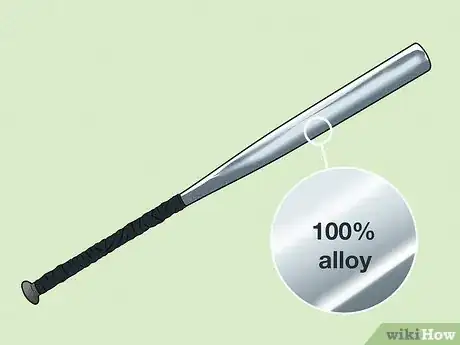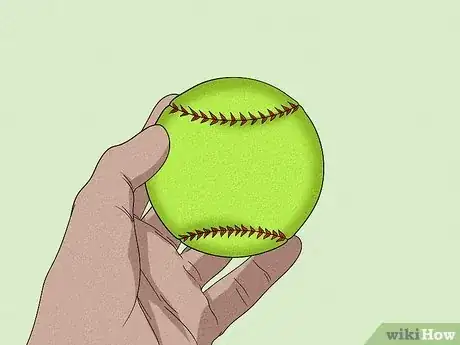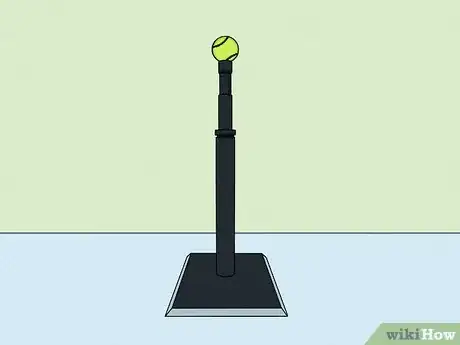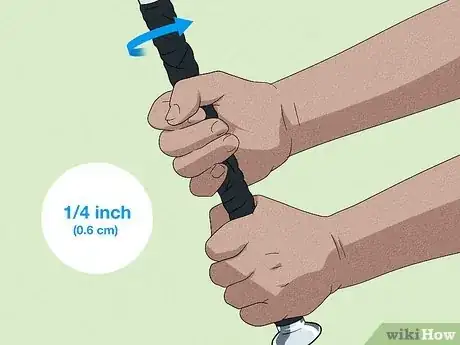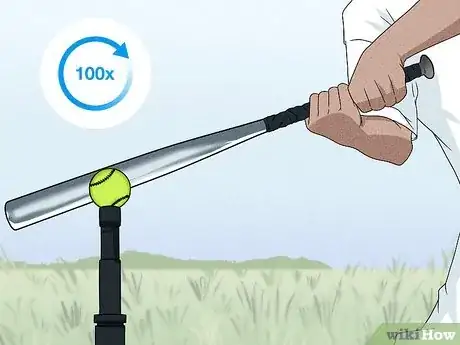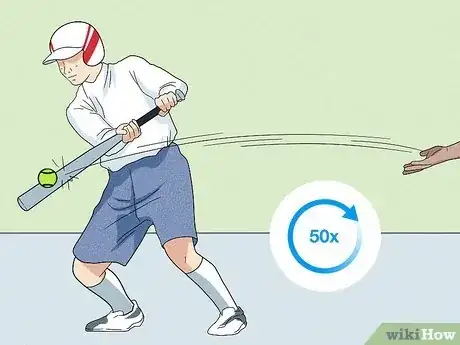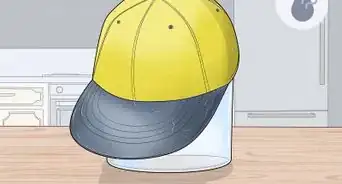This article was co-authored by Haley Snyder. Haley Snyder is a former Division I Student-Athlete and Softball Player. With over a decade of experience, she specializes in softball mechanics, fundamentals, and pitching. Haley holds a BA and MA from Stanford University, where she competed in the PAC-12 Conference as a pitcher.
This article has been viewed 118,427 times.
Composite fast pitch softball bats are constructed of carbon fiber and reinforced with plastic. In order to maximize performance, experts recommend a break-in period for any new composite bat in order to strengthen and compress the fibers. While there are several illegal methods of breaking in a composite softball bat, the method approved by the American Softball Association involves hitting at half speed from a tee and gradually working up to full-speed swings for a total of 200 repetitions.
Steps
Getting Your Equipment Ready
-
1Make sure your bat needs to be broken in. Fast pitch softball bats that are 100 percent alloy, or that have an alloy barrel, are good to go right away, with no break-in period needed.[1] Composite bats, however, have carbon fibers that need to be loosened before the bat reaches optimum performance. The fibers can be loosened during just one break-in session that will take about an hour.
- Many fast pitch players hesitate to use a new composite bat in the middle of season, thinking that the break-in process is too time consuming. However, breaking in a new bat shouldn't take more time than a routine practice session.
- Don't be tempted to skip the process of breaking in your composite bat, since a fresh bat won't perform as well as one that's been broken in correctly.[2]
-
2Use real leather softballs. It's important to use high quality, regulation-size softballs with leather skin and good stitching to break in your bat. If you're breaking it in at a batting cage, go to a cage that uses real balls instead of the rubber balls (which usually have developed pock marks). The pock-marked balls can damage your bat, hindering its ability to perform well.
- Don't break in your bat during very cold weather. The softballs should be at least 60℉ (15℃). A cold ball can damage the bat before it is broken in properly.
Advertisement -
3Begin the process by hitting balls from a batting tee. Breaking in a bat requires hitting a certain number of balls at half the maximum impact force before you move on to full-impact fast pitch hitting.[3] The easiest way to bat at half-capacity is to bat off of a tee, rather than having someone pitch to you. If you don't already have a tee, buy one at a sporting goods store and keep it as part of your practice equipment.
- The alternative to using a tee would be hitting half-speed pitches or slow pitches. This would break in the bat effectively, but it might not be great for your batting form. Hitting half-speed pitches, especially when they have an arc, can mess with your form and timing.
Breaking in the Bat
-
1Rotate the bat 1⁄4 inch (0.6 cm) between swings. Rotating the bat between swings will ensure that the entire barrel gets broken in.[4] Many composite bats are marked around the diameter so you know exactly how much to turn the bat. It's important to rotate the bat during the entire breaking-in process so the bat won't get damaged or neglected in any one area.
-
2Take 100 swings from a tee. Using the correct form, hit about 100 balls from a tee. You'll be hitting the ball at about half of your normal power. These first 100 swings at half power will begin the work of gradually breaking in your bat.
- To make the process go faster, have someone help you by setting up new balls on the tee before every swing.
- You can take more than 100 swings if you desire. However, don't do less than 100, since the bat needs to be broken in gradually. Moving to a full-speed swing too quickly could damage the bat.
- Instead of randomly hitting with different parts of the bat, try to line up the bat so the brand name is facing you. After you've done some reps with this setup, switch sides[5]
- The more you hit the bat in 1 spot, the quicker it will break.[6]
-
3Hit 50 short lobs. Have someone lob pitches from a short distance, and aim to take about 50 swings this way. Hitting a short lob will require a slightly faster speed and harder contact, continuing the gradual process of breaking in the bat.
- Short lobs are often used to help batters work on their form. Work with your coach or a friend to swing 50 times this way.
- If no one is available to pitch short lobs, you can use a pitching machine. Adjust it to pitch slowly and without an arch so you don't have to change your form to make contact.
- Hitting reps are a great way to break in your bat.[7]
-
4Hit 50 fast pitches. To finish breaking in your bat, hit 50 regular fast pitches at full speed. You'll notice at first that your hits don't travel as far or as fast, but as you gradually break the bat in you'll be able hit at full capacity. Keep hitting fast pitches until you're comfortable with how your bat is performing.[8]
- After 50 pitches, your bat should be broken in. However, if you're not quite willing to use it in a game, use it during batting practice a few times to make sure you're used to the way it hits.
Warnings
- Do not utilize wall thinning, barrel shaving, loading, painting or accelerated break-in techniques on your bat. Any bat that is noticeably altered by rolling, vising or hammering will be disqualified for use.⧼thumbs_response⧽
Things You'll Need
- New composite softball bat
- Softball tee
- Softball(s)
References
- ↑ https://www.baseballmonkey.com/learn/how-to-break-in-a-baseball-bat
- ↑ https://maruccisports.com/the-rundown/composite-bat-breakin-guide/
- ↑ https://maruccisports.com/the-rundown/composite-bat-breakin-guide/
- ↑ https://www.baseballmonkey.com/learn/how-to-break-in-a-baseball-bat
- ↑ Haley Snyder. Softball Player. Expert Interview. 23 June 2021.
- ↑ Haley Snyder. Softball Player. Expert Interview. 23 June 2021.
- ↑ Haley Snyder. Softball Player. Expert Interview. 23 June 2021.
- ↑ http://www.ripit.com/blog/how-to-break-in-a-new-composite-bat/
